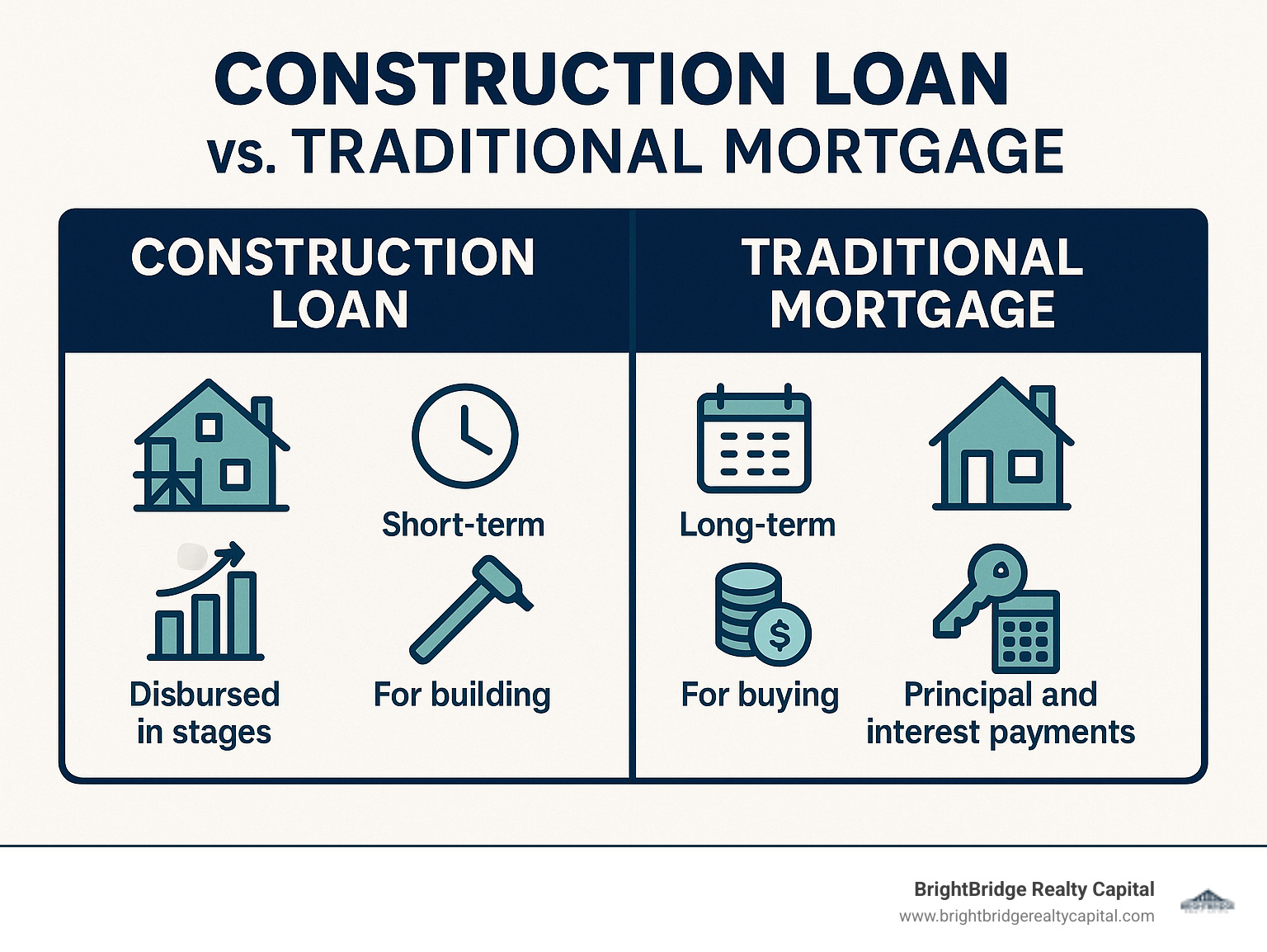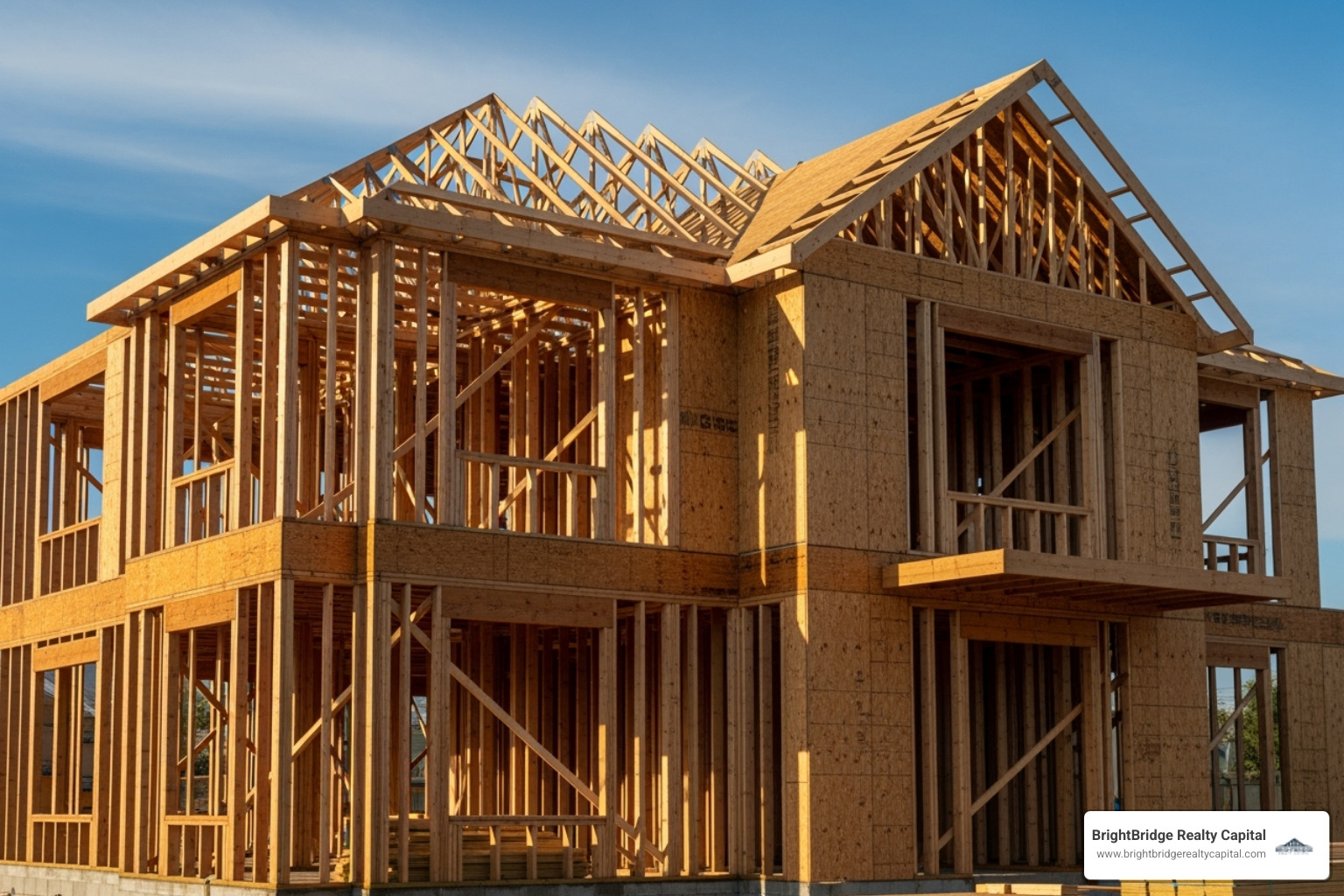Building Blocks of Finance: A Guide to Obtaining a Construction Loan

Understanding Construction Loans: Funding Your Vision from the Ground Up
Financing a new home build or a major renovation requires a specialized financial tool. To bring your vision to life, you must first understand how to get a construction loan. This type of financing is fundamentally different from a standard mortgage, as it's designed for a project that doesn't exist yet.
Here’s a quick look at the main difference:
- Construction Loan: A short-term loan (typically 12-18 months) used to finance the building of a home. Funds are not given in a lump sum; instead, they are released in stages (called "draws") as work progresses. Borrowers typically pay only interest on the funds that have been disbursed during the construction phase.
- Traditional Mortgage: A long-term loan (often 15 or 30 years) used to buy an existing, completed home. The full loan amount is provided at closing, and the borrower begins making principal and interest payments immediately.
This comprehensive guide will dig into the mechanics of construction loans, the stringent qualification requirements, and the step-by-step process to secure one. Whether you are a real estate investor planning a ground-up build or a future homeowner designing a custom residence, these loans are the financial engine that makes it possible.
I'm Daniel Lopez, a loan officer at BrightBridge Realty Capital. My expertise lies in structured financing, and I specialize in helping clients steer the complexities of how to get a construction loan. My goal is to provide you with the strategic insights needed to successfully fund your real estate projects. Let's explore the intricate functions of these loans.

Basic how to get a construction loan vocab:
A construction loan is a short-term financing instrument specifically designed to fund the costs associated with building a new property or executing a major renovation. Unlike a traditional mortgage where the collateral is a finished home, a construction loan's collateral is a work in progress. This makes it inherently riskier for the lender.
These loans typically last 6 to 24 months, a period that should align with your project's construction timeline. Because the home isn't built yet, the lender is taking a significant risk. If the project fails or the borrower defaults, the lender is left with an incomplete, difficult-to-sell asset. To compensate for this liftd risk, construction loan interest rates are usually about one percentage point higher than traditional mortgage rates and are often variable.
A well-structured construction loan can cover a wide array of project costs:
- Land Purchase: The cost of acquiring the lot. If you already own the land, the loan can pay off any existing lien, or your equity in the land can be used toward your down payment.
- Labor and Materials: This is the largest component, covering wages for the general contractor and all subcontractors (plumbers, electricians, etc.), as well as the cost of all building materials, from foundation concrete to roofing shingles and interior finishes.
- Permits and Fees: This includes a variety of administrative costs, such as fees for architectural and engineering plans, building permits, zoning permits, impact fees, and utility hookup charges.
- Contingency Reserves: A critical component. Lenders require a financial buffer, typically 10-20% of the construction cost, to cover unforeseen expenses, material price increases, or changes during construction.
- Interest Reserves: To ease the borrower's cash flow during the build, some loans allow a portion of the loan itself to be set aside to cover the monthly interest payments. This means you may not have to make out-of-pocket payments until the project is complete.
- Closing Costs: Fees associated with originating the loan, such as appraisal fees, title insurance, and attorney fees, can often be rolled into the total loan amount.
Construction loans generally do not cover items like furniture, home decor, or your personal living expenses during the build. You'll need to budget separately for rent or temporary housing.
How Construction Loans Work: Draws, Inspections, and Payments
Construction loans operate on a "draw schedule," a highly controlled, phased disbursement system. This process protects the lender's investment and ensures the project stays on track.
- The Draw Schedule: Before the loan closes, you, your builder, and the lender will agree on a detailed draw schedule. This document links loan disbursements to specific, verifiable construction milestones. Examples of milestones include: foundation poured, framing complete, roof on, windows and doors installed, drywall hung, and final finishes.
- Milestone-Based Disbursements: When the builder completes a milestone, they submit a "draw request" to the lender for the funds needed for the next phase of work.
- Lender Inspections: This is a crucial step. Before releasing each draw, the lender sends an appraiser or an independent inspector to the job site. Their job is to verify that the work for the current milestone has been completed correctly, according to the plans, and that the project is on budget and on schedule. This protects all parties by ensuring loan funds are used as intended.
- Interest-Only Payments: During the construction phase, you typically make interest-only payments. A key feature is that you only pay interest on the funds that have been drawn to date, not the total loan amount. For example, if your loan is for $500,000 but only $150,000 has been disbursed for the foundation and framing, your monthly payment is calculated based only on that $150,000.
- Paying on Drawn Funds: As construction progresses and more funds are drawn, your interest-only payments will gradually increase. Once construction is finished, the construction loan must be addressed. It is either paid off in full (if it was a construction-only loan) or it converts into a standard principal-and-interest mortgage (if it was a construction-to-permanent loan).
This meticulous system ensures funds are released responsibly, mitigating risk and keeping the project moving forward. For more details, you can explore resources like Construction Loans: Funds To Buy Land and Build.
Construction Loans vs. Traditional Mortgages
Understanding the fundamental differences between construction loans and traditional mortgages is essential for any prospective builder or real estate investor.
Here's a detailed table comparing the two:
| Feature | Construction Loan | Traditional Mortgage |
|---|---|---|
| Purpose | To finance the building of a new home or a major renovation project from the ground up. | To purchase an existing, completed home or to refinance an existing mortgage. |
| Loan Term | Short-term, typically 6-24 months, designed to cover only the construction period. | Long-term, typically 15 or 30 years, designed for homeownership over many years. |
| Fund Disbursement | Funds are disbursed in stages ("draws") as specific construction milestones are met and verified by an inspector. | Funds are disbursed as a single lump sum to the seller at the closing of the real estate transaction. |
| Interest Rates | Typically higher and almost always variable, tied to a benchmark like the prime rate. This reflects the lender's higher risk. | Generally lower and often available as a fixed rate for the life of the loan, providing payment stability. Variable options also exist. |
| Down Payment | Higher, typically requiring 20-25% of the total project cost (land + construction). This is often expressed as a Loan-to-Cost (LTC) ratio. | Can be as low as 3-5% for conventional loans, or even 0% for government-backed programs like VA or USDA loans. |
| Collateral | The unbuilt or partially built property, along with the building plans. This is considered risky collateral for the lender. | The fully built, existing property, which serves as stable and easily valued collateral. |
| Payments During Loan Term | Interest-only payments are made on the funds that have been drawn to date. Payments increase as the project progresses. | Principal and interest payments begin immediately after closing and remain consistent for fixed-rate loans. |
| Risk to Lender | Higher risk due to the potential for construction delays, cost overruns, and the fact that the asset (the home) does not yet exist. | Lower risk, as the asset is already established, its value is known, and it can be readily sold if the borrower defaults. |
Due to these differences, construction loans have stricter qualification requirements and a more intensive underwriting process. Lenders need to approve not just the borrower, but also the builder and the entire project plan. However, for investors and custom home builders, they are an indispensable tool for creating new real estate assets.
The Step-by-Step Guide on How to Get a Construction Loan

Securing a construction loan is a more involved process than getting a standard mortgage, but it can be steerd smoothly with proper preparation. At BrightBridge Realty Capital, we specialize in streamlining this process for real estate investors, focusing on fast closings and reliable funding.
Here is a detailed breakdown of how to get a construction loan, from initial financial prep to final project completion.
Step 1: Strengthen Your Finances and Get Pre-approved
Before you even look at land or interview builders, the first step is a thorough financial self-assessment. Lenders scrutinize construction loan applicants carefully due to the inherent risks of building from scratch.
- Credit Score: Aim for a credit score of 680 or higher, with scores above 720 being ideal. Lenders see a strong credit score as an indicator of reliability and responsible financial management. They will review your entire credit history, looking for a consistent record of on-time payments and responsible credit utilization.
- Debt-to-Income (DTI) Ratio: Your DTI ratio compares your total monthly debt payments (e.g., mortgage, car loans, student loans, credit card minimums) to your gross monthly income. Most lenders prefer a DTI below 45%, and some may require it to be under 43%. This ratio shows the lender you have enough income to handle your existing obligations plus the new construction loan payments.
- Down Payment / Equity: Construction loans typically require a larger down payment than traditional mortgages. Expect to need 20-25% of the total project cost (the cost of the land plus the cost of construction). This is often expressed as a Loan-to-Cost (LTC) ratio; for example, a lender might offer an 80% LTC loan, meaning you must cover the remaining 20%. If you already own the land, your equity in the land can often be used to satisfy a large portion of this requirement.
- Cash Reserves: Lenders will want to see that you have significant liquid assets (cash or easily sellable investments) beyond the down payment. These reserves, often equal to 6-12 months of loan payments, serve two purposes: they demonstrate your financial stability, and they provide a cushion to cover unexpected costs or delays during construction.
Getting pre-approved early in the process is a crucial strategic move. A pre-approval from a lender like BrightBridge Realty Capital clarifies your borrowing capacity, which is essential for creating a realistic budget with your builder. It also demonstrates to land sellers and contractors that you are a serious, qualified buyer ready to move forward.
Step 2: Develop Your Project Plan and Hire a Builder
With your finances in order, the next phase is to define the project itself. A lender will not approve a loan based on a vague idea; they need a concrete, detailed plan.
This plan must include:
- Detailed Architectural Plans: These are the official blueprints for your project, created by a licensed architect. They must specify all dimensions, materials, and finishes.
- Comprehensive Construction Budget: This is a line-item breakdown of all estimated costs, often called a "Schedule of Values." It should include everything from site preparation and foundation work to framing, roofing, HVAC, plumbing, electrical, interior finishes, and landscaping. It must also include a contingency fund of at least 10%.
- Project Timeline: A realistic schedule outlining each phase of construction and its expected completion date.
Choosing the right builder is one of the most critical decisions you will make. Your lender will need to approve your builder, so they must be an experienced, licensed, and insured professional with a solid track record.
When vetting potential builders:
- Ask for a portfolio of their completed projects and references from at least three recent clients and key suppliers.
- Verify their license and insurance status with the state licensing board.
- Check their reputation with the Better Business Bureau and online review sites.
- Ask detailed questions about their process for handling change orders, communication protocols, and warranty coverage.
- Consider builders who are members of professional organizations like the National Association of Home Builders (NAHB). You can often find a builder in your area through their directories.
Working closely with your chosen builder from the beginning is key to developing an accurate budget and timeline, which are essential for your loan application.
Step 3: Gather Documentation and Formally Apply
Once your financial house is in order and your project plan is complete, it's time to gather the extensive documentation required for a formal loan application. Being thoroughly prepared is the key to a fast and smooth underwriting process, a hallmark of working with BrightBridge Realty Capital.
You will typically need to provide a comprehensive package that includes:
- Personal Financial Statements: This includes recent pay stubs, W-2s or 1099s for the past two years, federal tax returns, and statements for all bank and investment accounts. You'll also need a detailed list of your assets and liabilities.
- Detailed Builder Contract: A legally binding, signed agreement with your builder. It must outline the full scope of work, the total cost, the draw schedule, and the projected completion date.
- Architectural Plans and Specifications: The complete set of blueprints and a detailed list of materials (a "spec sheet").
- Proof of Land Ownership or Purchase Agreement: If you own the land, you'll provide the deed. If you are purchasing the land with the loan, you'll provide the signed purchase contract.
- Detailed Project Budget and Timeline: The comprehensive cost breakdown and construction schedule you developed with your builder.
- Builder's Credentials: Copies of your builder’s general contractor license, liability insurance, and workers' compensation insurance.
- Appraisal: The lender will order an appraisal that estimates the property's future value "subject to completion" based on your plans and specifications. This appraisal is crucial for determining the final loan amount, as lenders will also consider the Loan-to-Value (LTV) ratio.
Submitting a complete and well-organized application package is the fastest way to get through underwriting and receive your loan approval.
Step 4: Managing Your Project and Loan Disbursements

Once your loan closes, construction can officially begin. The loan is now managed through the draw process you established earlier.
As your builder completes each agreed-upon milestone, they will submit a draw request to the lender. Before releasing any funds, we arrange for third-party inspections. An inspector visits the site to verify that the work is completed to the required standard and aligns with the project timeline. This rigorous oversight protects both your investment and ours, ensuring that the project is being built as planned.
Following a successful inspection and lender approval, we release the funds for that specific draw. The funds are typically paid to your builder or through a title company/escrow account to ensure subcontractors and suppliers are paid promptly.
Throughout the construction period, you will be responsible for making interest-only payments on the cumulative amount of funds drawn so far. Your active project management is also vital. Maintain open and regular communication with your builder, conduct your own site visits, and address any issues or change orders promptly and formally.
At BrightBridge Realty Capital, our direct lending model and experienced team ensure efficient and timely draw administration. We understand that keeping your project funded and on schedule is paramount to your success.
Navigating Your Options: Loan Types and Special Programs
Construction loans are not a one-size-fits-all product. The best option for you will depend on your specific project, your long-term financial strategy, and your goals as a homeowner or real estate investor. At BrightBridge Realty Capital, we specialize in offering flexible financing options designed for the diverse needs of the modern real estate investor.
Common Types of Construction Loans
Understanding the primary loan structures is the first step in choosing the right path. For investors and custom home builders, the choice often comes down to one of these structures.
Construction-to-Permanent Loan: Often called a "single-close" or "one-time close" loan, this popular option combines your construction financing and your long-term mortgage into one single transaction. You go through one application and one closing. During the build, you make interest-only payments. Upon the home's completion, the loan automatically converts to a traditional, long-term mortgage with principal and interest payments.
- Pros: Saves time and money by having only one set of closing costs. You can lock in your permanent mortgage interest rate at the beginning, protecting you from future rate hikes.
- Cons: Less flexibility. If mortgage rates drop significantly during construction, you may be stuck with the higher rate you locked in.
Construction-Only Loan: Known as a "two-close" loan, this is a short-term loan that covers only the building phase. You make interest-only payments on the drawn funds during construction. Once the project is complete, the loan is due in full. You must then pay it off, which typically requires you to secure a separate permanent mortgage (the "second close").
- Pros: Offers flexibility. You can shop around for the best possible mortgage rates and terms once the home is complete. This can be advantageous in a falling-rate environment.
- Cons: Involves two separate application processes and two sets of closing costs, which can be more expensive. You also face the risk that you may not qualify for a permanent mortgage upon completion, or that interest rates could be significantly higher.
Renovation Loan: Ideal for investors looking to buy and upgrade existing properties (a "fix-and-flip" or "buy-and-hold" strategy). These loans combine the purchase price and the renovation costs into a single loan. Crucially, they are often based on the property's "after-repair value" (ARV)—the estimated value of the home after all improvements are made. This allows you to finance the improvements needed to boost property value and generate instant equity or higher rental income.
At BrightBridge Realty Capital, we deliver customized ground-up construction loans custom for investors. Find out more about our ground up construction loans.
Government-Backed and Other Special Programs
While many investors use private or conventional financing, it's worth being aware of government-backed programs, as they can be an option for certain owner-occupant builders.
- FHA Construction Loan: A type of construction-to-permanent loan insured by the Federal Housing Administration. It allows for a low down payment (as little as 3.5%) and is accessible to borrowers with less-than-perfect credit. However, it comes with stricter property standards and loan limits.
- VA Construction Loan: For eligible veterans, service members, and surviving spouses. These loans, guaranteed by the Department of Veterans Affairs, can offer 0% down payment financing. Finding lenders who offer true, $0-down VA construction loans can be challenging, but they are a powerful option.
- USDA Construction Loan: For building homes in eligible rural areas, these loans from the U.S. Department of Agriculture also offer 0% down payment options for low- to moderate-income borrowers.
How to get a construction loan with flexible qualification options
At BrightBridge Realty Capital, we recognize that the financial profile of a real estate investor is often different from that of a typical homebuyer. Our direct lending approach allows us to offer custom financing solutions nationwide, often closing deals in a fraction of the time of traditional banks.
When you're exploring how to get a construction loan, understand that we work to find solutions for various financial profiles. While strong personal finances are always beneficial, our expertise is in crafting loans that fit the specific project. We look beyond standard metrics to conduct a holistic review of the deal. This means we analyze your investment strategy, your real estate experience and track record, the economic viability of the project itself, and the strength of the local market.
Instead of forcing your project into a pre-defined box, we build the loan around your project's potential. This may involve creative loan structures, cross-collateralization, or leveraging other assets to make the deal work. Our eligibility requirements are designed for active real estate investors, focusing on project strength and your demonstrated ability to execute your plan. We encourage you to contact BrightBridge Realty Capital to discuss your project. Our team can design a construction loan that aligns with your investment goals, providing competitive rates and the quick capital you need to seize opportunities.
Frequently Asked Questions about Construction Loans
Here are detailed answers to some of the most common questions that arise as you learn how to get a construction loan and prepare to manage your project.
Can I get a construction loan if I act as my own general contractor?
Securing a construction loan as an owner-builder is exceptionally rare and challenging. The vast majority of lenders, including BrightBridge Realty Capital, require that projects be managed by an experienced, licensed, and insured general contractor. The reason is risk mitigation. Owner-builder projects have a statistically higher risk of significant delays, major cost overruns, failure to meet building codes, and lower-quality workmanship.
A general contractor brings an established network of vetted subcontractors, deep knowledge of the permitting process, and the project management expertise needed to keep a complex build on schedule and on budget. To even be considered, an owner-builder would need to present a flawless project plan and demonstrate extensive, professional-level construction experience, often including holding a valid contractor's license themselves. For most investors, the most efficient and successful path is to partner with a professional contractor.
What happens if construction goes over budget or is delayed?
Even with meticulous planning, unexpected issues can arise in any construction project. It's crucial to understand how these are handled.
- Cost Overruns: As the borrower, you are ultimately responsible for covering any costs that exceed the approved loan amount. This is precisely why lenders require a contingency reserve (typically 10-20% of the construction budget) to be included in the initial loan. This reserve is your first line of defense. If costs exceed both the budget and the contingency reserve, you will need to cover the difference with your own funds (out-of-pocket). It is very difficult to increase the loan amount mid-project.
- Delays: Construction timelines can be impacted by weather, supply chain disruptions, or subcontractor scheduling. If your project faces a significant delay that pushes it beyond the loan's maturity date, you must communicate with your lender immediately and proactively. You will likely need to request a loan term extension. This process typically involves explaining the reason for the delay, providing a revised completion date, and may require re-approval and the payment of extension fees.
At BrightBridge Realty Capital, our direct lending model fosters open communication, allowing us to work with you to find pragmatic solutions when unexpected challenges arise.
Are construction loan interest rates fixed or variable?
Construction loan interest rates are almost always variable. This means the rate can fluctuate during the construction period. The rate is typically tied to a benchmark index, most commonly the Wall Street Journal Prime Rate, plus a margin (e.g., Prime + 1%). There are several reasons for this structure:
- Short-Term Nature: These are short-term loans, and variable rates allow lenders to adjust to changing market conditions over the 12-24 month term.
- Lender Risk: Construction loans are high-risk. A variable rate helps the lender mitigate the financial risk associated with lending on an unbuilt asset.
- Phased Funding: Because the loan is funded in stages, a variable rate applied to the outstanding balance is a more straightforward way to calculate interest than a fixed rate on a constantly changing principal.
It is essential to budget for potential fluctuations in your interest-only payments. However, if you have a construction-to-permanent loan, you can often lock in a fixed rate for the long-term mortgage portion of the loan before construction even begins.
How is the total construction loan amount determined?
The final loan amount is determined by the lesser of two key calculations: the Loan-to-Cost (LTC) and the Loan-to-Value (LTV).
- Loan-to-Cost (LTC): This compares the loan amount to the total project cost. Total cost includes the land purchase price (or value) plus all hard and soft construction costs. Lenders typically cap LTC at 80-85%, meaning you must contribute 15-20% of the cost as a down payment.
- Loan-to-Value (LTV): This compares the loan amount to the appraised value of the completed home (the "after-completion value"). Lenders also have LTV limits, often around 75-80%. The lender will fund the lower of the two calculations to ensure they are not over-leveraged on the project.
Can I use land I already own as equity for the loan?
Yes, absolutely. If you own your land outright or have significant equity in it, this is a major advantage. The lender will have the land appraised, and you can use the equity value toward your required down payment. For example, if your total project cost is $600,000 and the lender requires a 20% down payment ($120,000), but you own land valued at $150,000, your land equity more than covers the entire down payment requirement. This can significantly reduce your out-of-pocket cash needs for the project.
What are the typical closing costs for a construction loan?
Closing costs for a construction loan are generally higher than for a standard mortgage due to the complexity of the process. They can range from 2% to 5% of the loan amount. Be prepared for fees such as:
- Loan Origination Fee: A fee charged by the lender for processing the loan, often 1-2% of the loan amount.
- Appraisal Fee: This is more expensive than a standard appraisal because it determines both the current land value and the future "subject-to-completion" value.
- Inspection Fees: You will have to pay for the inspector who verifies each stage of construction before a draw is released.
- Title Insurance and Search: To protect the lender's interest in the property.
- Attorney Fees: For document preparation and review.
- Permit and Survey Fees: If not already paid.
Conclusion: Laying the Final Foundation for Your Project
Understanding how to get a construction loan is the foundational first step in changing a blueprint into a physical asset. This guide has walked you through the entire lifecycle of this unique financing tool. We've detailed how these short-term, staged-disbursement loans function, the critical importance of the draw and inspection process, and the key differences that set them apart from traditional mortgages.
We have outlined the essential steps to success: strengthening your financial profile, creating a meticulous project plan with a qualified and vetted builder, and diligently managing the application, documentation, and disbursement process. The key to a smooth and successful build is comprehensive preparation. A solid financial footing, a detailed and realistic project plan, and a strong partnership with your builder and lender are the non-negotiable pillars of success.
At BrightBridge Realty Capital, we do more than just lend money; we partner with real estate investors to help make their ambitious goals a reality. We specialize in creating custom financing solutions for projects nationwide, with a focus on rapid, reliable execution and fast closings, often within a week. As direct lenders, we have the flexibility and expertise to structure loans that align with your investment strategy, providing competitive rates and a seamless, transparent process from start to finish.
Ready to build your next project? For serious real estate investors seeking fast, flexible, and reliable financing, we invite you to explore our ground-up construction loan options. Let our team of experts help you lay the financial foundation for your next successful investment.


